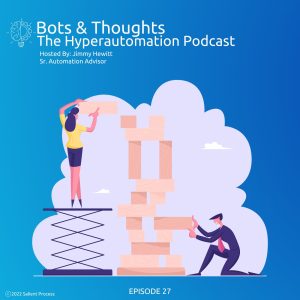
Follow along with the episode now!
 |
Roger Burltons’s background: Started Process Renewal Group in the 90’s. Felt businesses weren’t connecting the dots within their organization. Started doing a lot of process work and discovered better ways to work within an organization. Gradually started to work with organizations to make strategic decisions because they were thinking about the end-to-end the organization. Found almost every industry are facing the same issues.
|
Published his first book (2001): Business Process Management: Profiting from Process
Published his second book (2022): Business Architecture: Collecting, Connecting, and Correcting the Dots
Views Business Architecture as “Common Sense” and foundation for business.
Roger’s Education: Bachelor’s of Science in Industrial Engineer from University of Toronto
Says Business Architecture mindset is not mutually exclusive to Industrial Engineering. Believes it is a mindset that is hard to teach. He describes that you can teach techniques, but having the innate common sense, logic and perspective that they need to step back and see the bigger picture is hard to teach.
Hear Rogers explanation of the “The Business Architecture Mindset”
To me, Business Architecture is just figuring out who you’re serving, why you’re serving them, and then figuring out how you’re going to serve them.
Business Architecture tries to understand the outside world of the organization and you try to figure out how to line up the inside world of the organization in terms of the work you do, infromation you need and the tools you have to implement and execute and whether those tools should be put in the hand of the customer or through a call center. Architecture says, how do we best deliver against the expectations of those people sitting in the outside world!
It is about making sure we’re doing the right work for the right reason for the right people, at the right time.
We’re making sure that everything we’re building or spending our money on improving is actually helping make that happen. So it’s keeping that traceability from the need all the way through to all the things we build, all the things we implement, all the people we hire, all the partners we have, making sure all that stuff is connected to the right outcomes. Business architecture will connect the dots. That’s one of the things in the book, right? Connect the dots. But connect the dots.
Service-Oriented Companies
really have to get their systems down, and because it’s so competitive. If you don’t stay with it and don’t get it right- it doesn’t matter if you have great leaders in each department, it still won’t be right. You’re going to suffer in the marketplace. Now what that what that says is, and it’s not this is not universally true because there are exceptions to this. So, it means that organizations which are more like government or monopolistic. I am working with a power company now.
Believe’s it to best Business Architecture success comes from the nature of an organization because their motivators aren’t just quarter results and next year’s bonus but on making good decisions about the long-term health of the organization.
We have to see Business Architecture as a way of life and not as a project. It is not a diet where you can go on a diet, get it off, think I’m good and then go back to the way I was. It’s actually about if you want to lose the weight, you have to change your lifestyle. You have to start with a diet, but better you have to commit to changing. It’s about building and continuing to grow sustainably.
We don’t understand the impact of what we’re doing because we don’t spend enough time analyzing those, that synthesis. So, if I change, if I change how I run my process, I might mess up the next process. Or if I change what I want in the process, I might need different data that I don’t have. Or if I change the data, I don’t, or if I stop doing something. I may not realize that downstream somebody needs that information for regulatory reporting. And so pulling all it together, like the data, the process, the various capabilities we build, you know, all of those strategies have to make sense with one another. So if I go, I’m going to go pull, as you mentioned, pulling strings, if I pull on this string, I look in the ball of wool and I can see something else moving. I want to know what it is. before I change it.
The main goal here is to steer clear of unexpected consequences when we implement changes. The world we operate in is immensely intricate, but we can mitigate this complexity by clearly defining our processes, understanding the information we’re working with, deciphering policies and rules, and evaluating our skills, competencies, and overall culture. By doing so, we can determine the kind of performance we’re aiming for and, critically, we can assess how any alteration might affect all these interconnected elements. It’s like dipping our toes in the water before diving headfirst into designing and building systems.
Typically working with C-suite executives or one position below is the ideal target because you need the commitment of senior people to do things differently.
While we have a framework, our approach primarily emphasizes freedom within it. This means that if you follow the general principles but occasionally begin from a different point or focus on information aspects instead of process aspects, it’s because we adapt to where individuals are, their readiness, and the nature of their specific problems.”
The story revolves around a consultant’s experience with a client who initially worked at a large bank in the secured lending division. This client sought the consultant’s help after hearing them speak at a conference. Together, they transformed the mortgage department and laid the groundwork for a significant technology platform.
However, the central focus of the story shifts when the client moves to a large health insurance provider on the West Coast. Upon taking the new position, the client immediately contacts the consultant for assistance once again. Together, they engage senior vice presidents and directors in a comprehensive training program. This program involves stakeholder analysis, defining a vision (the North Star), and developing a process architecture. Each leader becomes a champion for specific processes, resulting in positive changes within the organization and improved performance. The story underscores the importance of internal leadership support in achieving successful transformations.
The story revolves around a poorly managed but profitable organization that specialized in equipment resale auctions, particularly heavy-duty machinery. Despite their success, new leadership aimed for rapid growth, attempting to introduce numerous new products. However, the organization faced significant challenges, including the inability to generate accurate bills and reconcile their operations. A consulting team was brought in to help address these issues by developing an architecture for better operations and billing processes.
Amid these efforts, the organization was swayed by an external firm promoting agile product development, which led to a disjointed and disconnected introduction of new products. This lack of cohesion resulted in customer confusion, employee departures, and a loss of internal capacity to run the business effectively. The organization’s focus on growth came at the expense of providing quality service and retaining customers, leading to a decline in their customer base.
Despite the consulting team’s efforts, they struggled to gain the attention of the executive team, ultimately resulting in a failure to enact meaningful change within the organization.
Roger Burlton, drawing from his experiences, discusses business architecture practices globally. He highlights the disciplined approach seen in Scandinavian countries, particularly Norway, which has been influenced by a focus on quality, compliance with international standards, and a structured mindset. In Saudi Arabia, a notable emphasis on business architecture is evident across various industries, with the country successfully implementing national hospital and health systems based on this framework. It remains unclear whether this discipline stems from abundant opportunities or cultural factors, but it is a recognized need.
In contrast, Burlton notes the varying landscape in the United States, with some organizations excelling in commitment to excellence while others lack focus and rely on quick fixes. He suggests that the cultural and leadership mindset within organizations plays a significant role in determining their approach to business architecture. Overall, Burlton observes diverse practices and levels of commitment to business architecture on a global scale.
The story revolves around the importance of two key aspects in a method or approach, particularly in the context of decision-making and design.
This understanding serves as a consistent set of criteria for making choices and investments. These choices should not be influenced by personal opinions or internal motivations but rather by the genuine needs of the external world, making decision-making less subjective.
This segmentation ensures that each part contributes value, making it easier to trace and comprehend the impact of various elements in the process.
In a nutshell, when dealing with a limited budget customer, the approach is to initially get a broad understanding of the entire process without going too deep into the details. Then, prioritize the areas that are both strategically important and causing problems. Focus on these specific areas, delve deeper into them, and make improvements. The key is not to get lost in the details too early and be comfortable with some level of uncertainty. Instead of trying to understand everything perfectly, it’s better to take action, prove your value, and make a difference.
Technology plays a crucial role in supporting Business Architecture in two main ways. First, it enables the execution of complex processes, ensuring seamless operations, and data flow. For example, in online shopping, from clicking to delivery and payment, technology connects everything without requiring human interaction. Similarly, in sectors like insurance, technology facilitates tasks like processing claims without direct human involvement, which is critical for operational efficiency.
Secondly, technology is essential for Business Architects themselves. Architects need tools to manage and organize the intricate components of business processes, data, and rules. These tools provide an inherent structure, allowing architects to see how different elements are interconnected. For instance, an architect needs to know if a specific business rule affects multiple processes, ensuring that changes to the rule won’t unintentionally disrupt other processes. In essence, technology serves as a knowledge management tool for architects, helping them avoid unintended consequences and efficiently manage complex business systems.
From what I’ve seen, you guys are well on the way to figuring it all out. So, congratulations.”
Business Architecture’s lineage draws from two main communities: enterprise architects and process improvement practitioners. Enterprise architects traditionally focus on defining technology infrastructure and how it supports business operations. They’ve realized the importance of understanding the business to enhance their work. On the other hand, the process improvement community, known for practices like lean and Six Sigma, has historically aimed to optimize processes. Over time, they recognized the need for a broader perspective on how processes fit into the larger business context.
These two communities bring distinct perspectives, and there has been some historical clash in their approaches. However, organizations are increasingly finding ways to harmonize these perspectives, resulting in a more unified understanding of Business Architecture. Today, these communities are working together more effectively, enhancing the overall approach to Business Architecture.
If you have a topic idea, contact us today. We want our podcast to answer your questions, and if you have something that you want to hear, we would love to know. In addition, you can ask questions and get in touch with our Salient Process team.
At Salient Process, we understand the importance of comprehensive digital transformation. We work closely with each client and use a North Star methodology to align your procedures with overall business goals. Our expert team works hard to understand your unique needs, making a customized plan for success. With our Digital Business Automation solutions, you can move closer to your digital transformation goals.